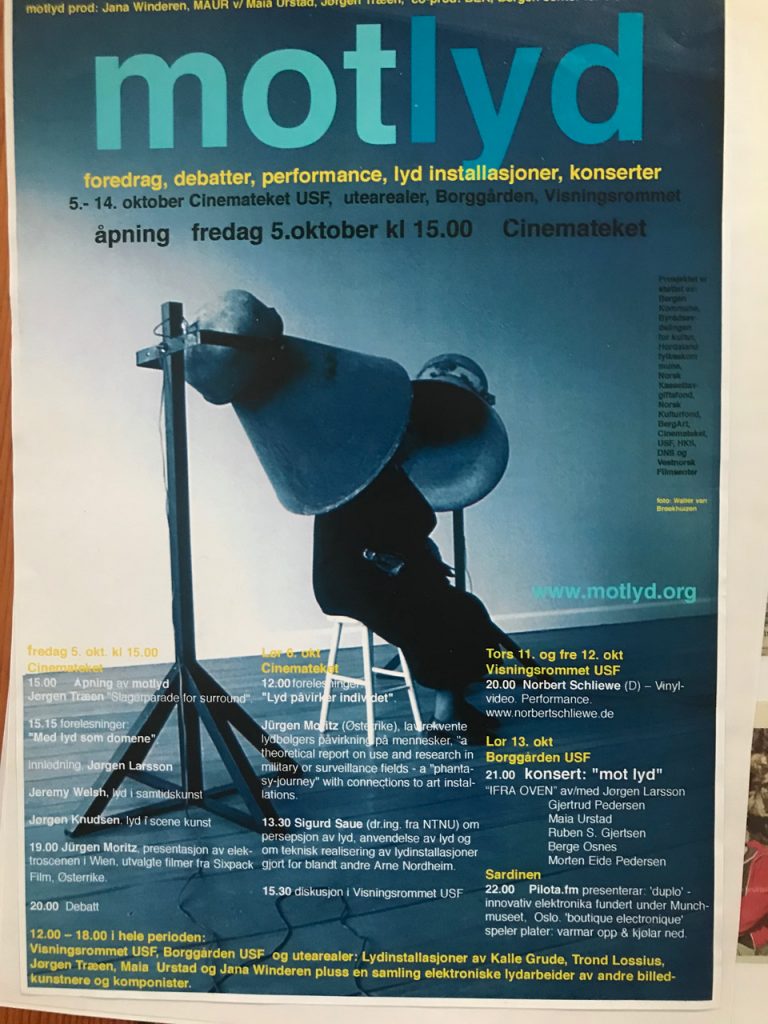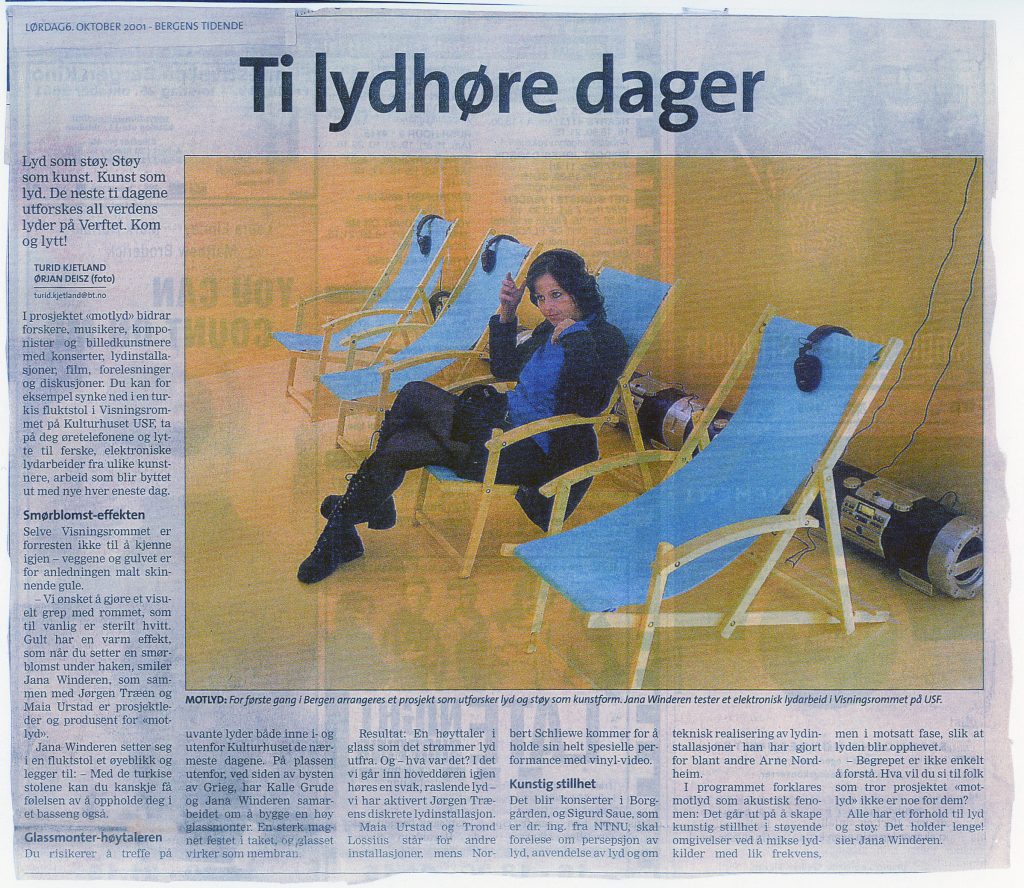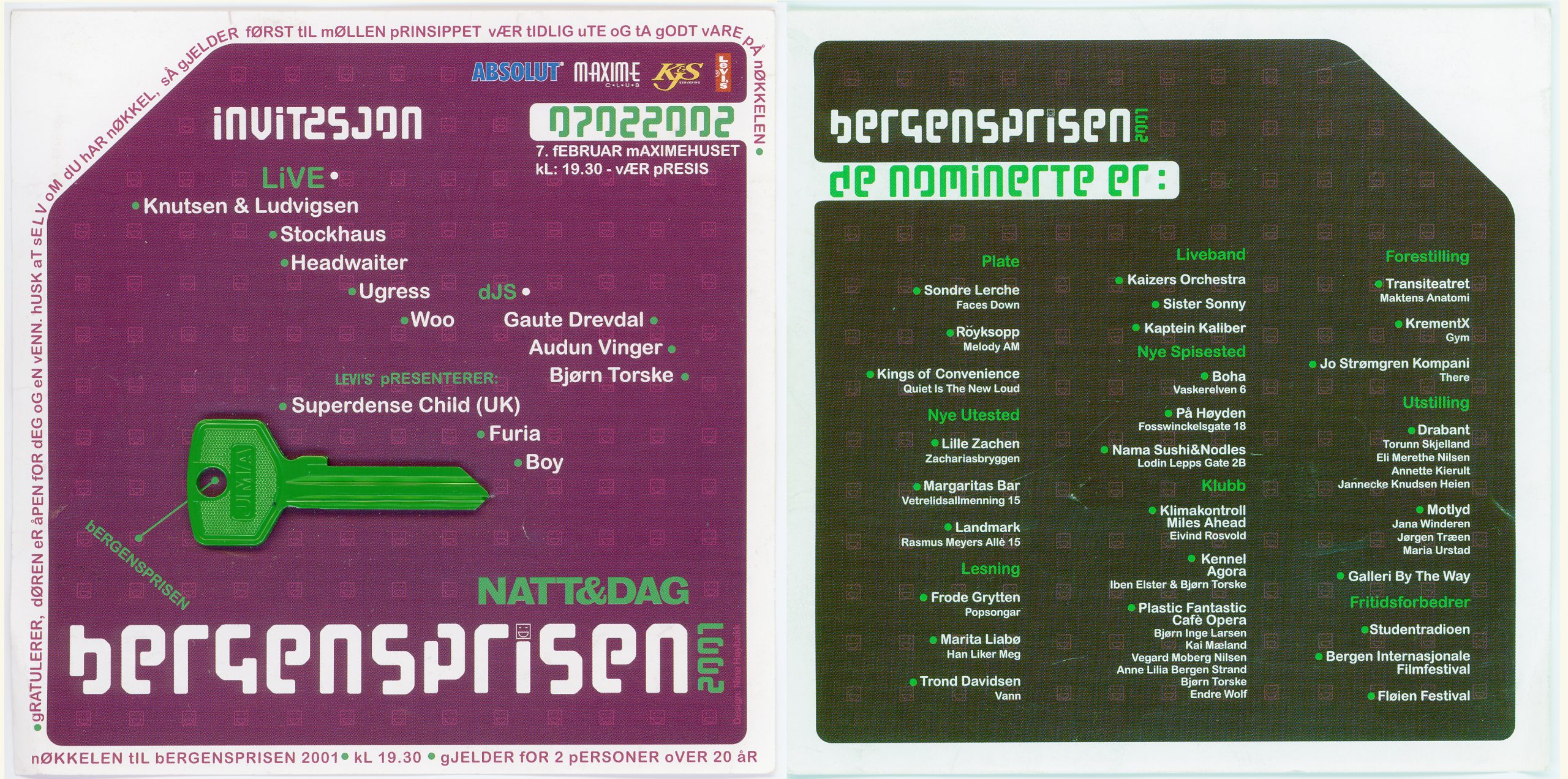motlyd – a festival of sound
Published

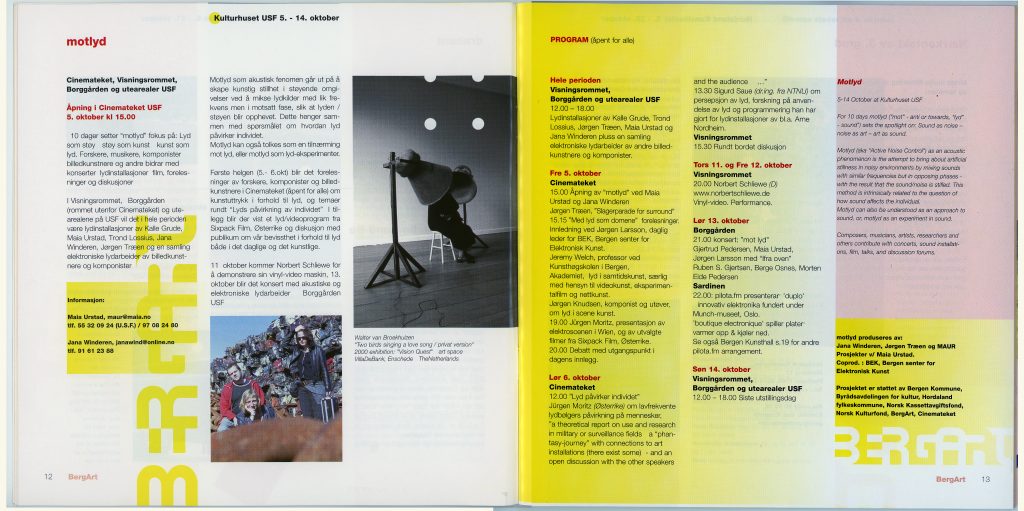
The festival motlyd (noise-cancelling) took place at USF Verftet for 10 days between 5 and 14 October 2001. It was composed of concerts, installations and a film programme, in addition to a series of lectures.
A conversation about motlyd, between the initators Maia Urstad (MU), Jana Winderen (JW), and Jørgen Træen (JT), and Sissel Lillebostad (SL). Bergen, 20.08.2020
SL: In science, sound has long been an area for constant investigation and research. motlyd perhaps represented the first entrance to sound as artistic material — in Bergen, perhaps in Norway. What did you want with the festival?
MU: We all worked with sound. Both Jana and I had a background in visual art, and we were interested in the field in between. So the ambition was to have a festival, to learn something new, to invite people, to listen and to be in a context that did not exist before.
JT: Yes, and create a context where you could experiment a bit. At least I had a great curiosity to try things out.
MU: Yes — this was a research project. It was about bringing in people who could say something about different sound-related topics.
JW: The first idea for motlyd was inspired by a text by Anna Karin Rynander, who made the sound installations at Gardermoen [Oslo airport]. She had made a ‘desk project’ about the possibility of making a quiet corridor, outdoors. That is, the theory of it, because it is theoretically possible, but it is completely insane. We thought we could make a wall of silence between the construction site and USF, for the year of Bergen being European Capital of Culture 2000. It was completely absurd to have a whole year of being a Capital of Culture, and then there would be a construction site right next to USF all the time. We started talking about noise as a phenomenon, and then Jørgen and I went up to the research organisation Sintef in Trondheim to look at the development of active noise reduction. Among other things, there was some incubator stuff that was designed for jets. They had to be soundproof to transport premature babies. Do you remember that we were inside the anechoic (echo-free) chamber?
JT: Yes. It’s something I mention in various contexts, to have been in such a room. It was incredibly strange.
JW: I remember trying to say something, but then it was as if the sound was stuck in my body and didn’t go anywhere. It was so incredibly uncomfortable, that feeling. Later I was asked to do a project inside such a chamber, but I said I would never go into a place like that again.
MU: You know, I had the exact opposite experience. At Haukeland University Hospital, they have an echo-free chamber, and I thought: I could become completely dependent on this. I was completely shackled; I thought it was so amazing.
JT: I only remember one small detail, because there was one light bulb hanging there. And that was the light. And when they made measurements, they unscrewed that light bulb and took it out of the room, so that they would not get errors in the measurements of the reflections in the light bulb.
JW: But what were they doing to keep it quiet?
MU: As I remember it, the theory behind noise-cancelling is that if it is a completely clear and distinct sine wave, then you send out the counter-wave to it. And then they are zeroed out.
JT: Yes, you have sound and then you have the same sound, but the phase is reversed. The problem is getting that sound through the microphone, the electronics, and reversing the phase quickly enough for an accurate phasing out.
JW: It’s not practically possible to do outside, with such unforeseen circumstances, right? I remember we talked about how we could do it inside controlled rooms.
MU: Yes, we talked about it, and then it probably became more interesting to think of it as a phenomenon that became a superstructure for all the things we wanted to do.
JW: Yeah, right. That’s where you had the fallen cows, right, Jørgen?
MU: Yes, it was part of that concert. Wait, I’ll read from the programme: «Borggården, Saturday 13 October. Here you will be presented with a concert performance you have hardly experienced before, with everything from compositions with fallen cows, deep bass clarinet tones, meditative soundscapes, to powerful expressive piano playing, in a wealth of sound.”

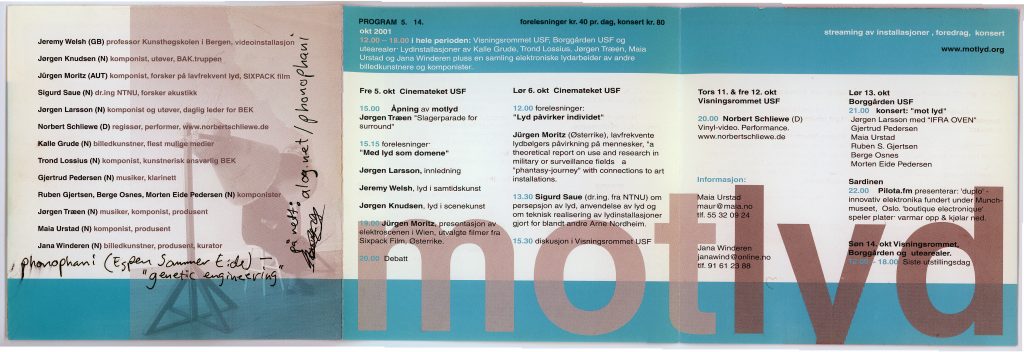

JW: I remember Jørgen Larsson. He played the piano up on the balcony.
MU: Yes, he did. He was on one balcony, and then Gjertrud Pedersen was on the balcony above and played ‘composition for clarinet in a sound room’, or something like that. And I made the music, so I wrote notes along the way. It was quite fun. And we used the whole room. There was something on the floor too, I think.
JW: We made that seat cushion system with a sound programme inside each of the windows in Borggården. With the turquoise PVC leather-stuff. Oh my God! It was amazing, really. And Kalle Grude’s glass display case with transducers on the glass that were to pick up sound from China. I think I had a Chinese opera inside that thing for Kalle. It was a bit magical.
MU: It was right outside the Visningsrommet [USF’s gallery] somewhere. We had that whole room, we painted it yellow, and turned it into a kind of pool with deckchairs. We went around to friends and relatives to borrow the chairs, painted them yellow, and dyed the fabric as well. And the whole thing was about making one room. Trond Lossius had four speakers in the inner yellow room, four in the outer, along with 10 synchronised boom blasters that I brought with me from another project. The point was to create a sound image that invited people into the deckchairs and headphones with ‘Today’s menu’, like a summer day at the beach.
JW: Do you remember the person who couldn’t come along: Jürgen Moritz? Moritz said that several people had committed suicide in an area with a lot of low-frequency sound. It affected them; they became depressed and stressed. It made a great impression on me.
MU: He had lived in the same area himself.
JT: I have read that there is a much higher death rate where there is a lot of subharmonic noise, especially in connection with underground, and miscellaneous sound.
JW: Yes. Think, for example, of wind turbines.
MU: To put it this way: the topic is highly relevant all the time. Like this pollution with fan heaters. There are no inhibitions there — the heaters are absolutely everywhere. And that really amazes me, because we are so conscious on so many other levels, but just when it comes to that kind of noise, we don’t hear it. And that’s very strange. It’s everywhere.
JT: And there have still been no examples of noise-cancelling to my knowledge, except in headphones. In order to be able to attenuate bass frequencies from fan systems and the like, an enormous amount of space is required. And so it’s insanely impractical, and damn expensive. So then it is not been done either. Probably because there’s not enough research on it.
SL: motlyd was extremely ambitious in a way, with everything you tried to put together within the framework of a project that was like “we just want to do something we think is nice”.
MU: Yes. But as the sum of interests between us, the programme became this. It was very much about doing things ourselves, of what we wanted to do. It was like “What happens if I do this?” or “How is this going?”, and “Can we do this?”. It was very much about using the entire USF. All rooms. As with that concert in Borggården; we used all the floors, we used the sound throughout the space. To use the whole space so that you went into a completely different space than you did the week before. I think it started then, this holistic approach to learning things, figuring things out and making things yourself. Films too!
JW: That programme, yes, it was a short film programme of some kind. I had completely forgotten about that. But what is important here is the whole noise-cancelling thing. That was the basis for the whole project. About the construction site. Even though it was not technically possible, it was still what was at the bottom of it all. It was nice to use as a starting point, because it is a hypothesis that one cannot prove. An idea that opens up a lot of different thoughts.
JT: It was very improvised, because we did not quite know what we were doing. It was kind of like just seeing what we got.
MU: But we made a lot of works ourselves.
JW: Yeah, it was a lot of work really, when I think about it.

In Theory
SL: What did the series of lectures, the theoretical programme, mean in a setting like this?
JW: It gave the opportunity for people to listen, to go in-depth on different topics, and have the opportunity to ask questions.
SL: But why were those in the programme invited? Was it specifically related to this idea of noise-cancelling, or did it happen to be people you knew and thought had something going on, and that you were interested in?
JT: There were probably things that interested us, on the border of what sound is.
MU: The different people who participated worked experimentally. A nice mix. For example, the lecture series with Sigurd Saue from NTNU [the Norwegian University of Science and Technology] who knew something about noise-cancelling. He is a researcher in acoustics.
JT: Sigurd Saue has also worked with Arne Norheim on his installations.
MU: But many were people we knew, from the city, and who we knew worked with these things. Jeremy Welsh gave a lecture. Jørgen Knutsen gave a lecture. It is just a great opportunity to learn something that does not have to be read. When you meet someone who knows something about a topic, it means that you are orally handed over something that the person has researched and found out about. I don’t remember how we got money for all this, but it was at least a feeling of “wow, that’s what we want, what we want to hear more about, here we can ask someone”. And then it was great to be many people together.
SL: Did you find that motlyd was important in establishing a form of research-oriented approach to sound?
JW: It’s like, you do what you’re interested in — because you want to find out for yourself, and then you want to share it with people.
MU: It was simply a great opportunity to get people who knew something about a topic to say something about it. I don’t think we thought so much about research exactly, we thought much more about what they knew and what we wanted to listen to. And I remember we had expectations of Moritz, because this knowledge of the low-frequency danger was quite special.
JW: Yes, outside human audible range. I don’t think I had begun to understand so much about frequency, on my part. Jørgen, you knew a lot more about sound. And you, Maia. Both of you knew more than me about low frequencies. By the way, it continued with the freq_out project, which is about different audible frequency ranges. But that was afterwards, in 2003. Eventually I learned more about resonance, frequencies and sound pressure than I could then, but it made an impression on me, I remember. Thinking about sound as a weapon for example, and how different vibrations and sound pressures affect our body, and other animals for that matter. It’s very interesting. That’s what you do, try to find out.
SL: I have a perception that the questions that Moritz raised, despite the fact that he did not appear, became important for motlyd as a festival. But also for the knowledge you have built your activity on, afterwards?
JW: There were things we found out by making motlyd. How does it work? And what is sound in different kinds of forms? In terms of having sound in headphones, or having the sound open in the room?
MU: That was probably why we did it, because we wanted it to happen. There was not very many of these kinds of projects before.
JT: I think it was a slightly strange mixture we ended up with, and which may not have been intentional. All such projects that are done now I think are very much cleaner. While this here was more whimsical and more of a kind of strange connection. It was much freer and more open.
JW: Yes, that’s true. That’s a nice thing.
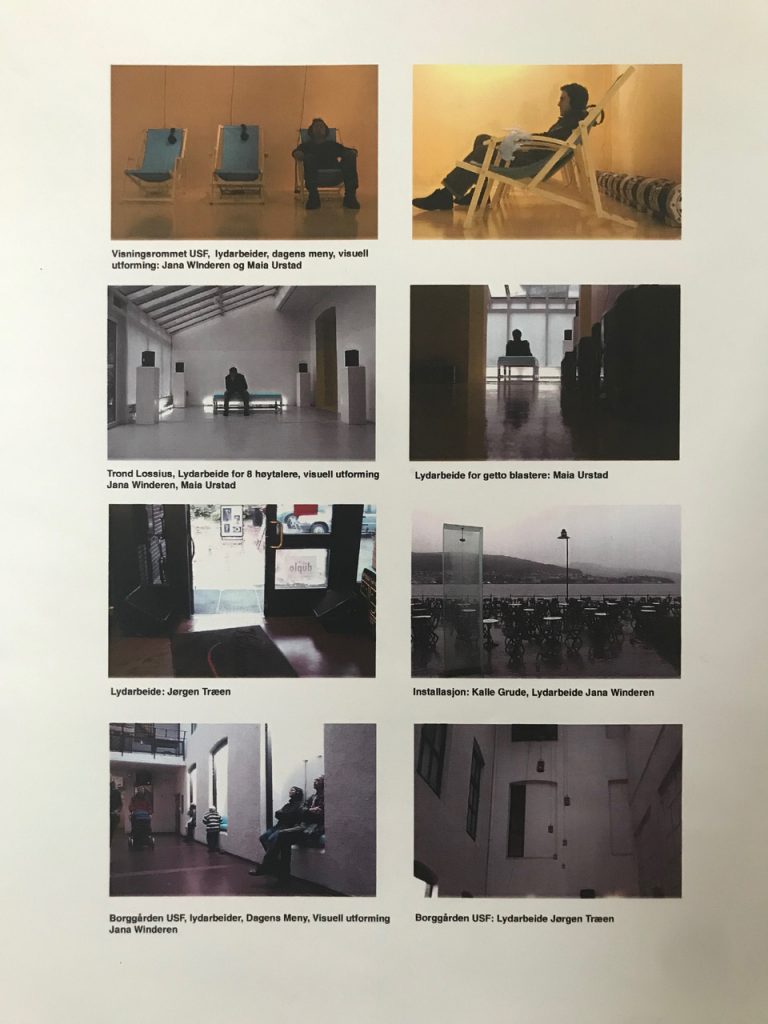
Fine mix
SL: To a certain extent, one can say that, at least here in Bergen, this was in the childhood of sound art, where one could still play in the same sandpit, and it was not so important who steered the train.
MU: Yes. We played in the same room too. I remember we had many things in one room. And they just had to fit together — and they did. If motlyd took a broad approach, then it was in such a way that everything fitted well together.
SL: Almost organically fused?
MU: Yes. The concert I think was pretty crazy. It was a huge event. Across all floors in Borggården. I’ve not seen that backyard being used to such an extent, it was a super weird instance.
SL: Did you record this? Do you have anything, really? Audio, video?
JT: Not that I know of.
JW: No, I don’t think so. I don’t think we documented it at all, really.
MU: I don’t think so. We were so busy getting it done.
SL: I was an audience member of motlyd, and remember that we were on our way into the wintertime, it was already starting to get quite grey around us, and we entered a room that was bright yellow. With deckchairs. With that action, you took away the whole serious, slightly high threshold to advanced contemporary art which sound art in many ways represents. The audience simply had a personal experience, and the setting was arranged to introduce me precisely to sound. It gave a lot of warmth to the project. And then it was this playfulness that the sound works represented.
MU: We got a whole bunch of great artists who just delivered CDs to us. We put the word out that people could deliver CDs, and when we had enough, we put them on ‘Today’s menu’. It was a nice project.
JW: How was it communicated to people at that time?
MU: That’s a good question! I think it was the word of mouth, really.
JT: Flyers.
MU: So we sat and waited to see who would deliver. And then we wrote down by hand who it was. Audun Eriksen, and Jazzkammer.
JW: Jørgen Knudsen was there, I think.
MU: I remember Peter Castine, he had an artist residency at USF and at BEK. And then there was Der Brief. And Knut Vaage. And Düplo, with ‘Å spille på en øse’ (‘Playing on a ladle’). Was it Andreas Mæland?
JT: Andreas Mæland was probably in Düplo, yes.
MU: Yeah, I believe so. ‘Arm live at the Safe As Milk Festival 2001’. And then there was Jana yes, and Love Tutorials.
JW: What was so nice about Bergen was that you could mix different things. There were many more opportunities for collaboration. We had that especially in this project here, right?

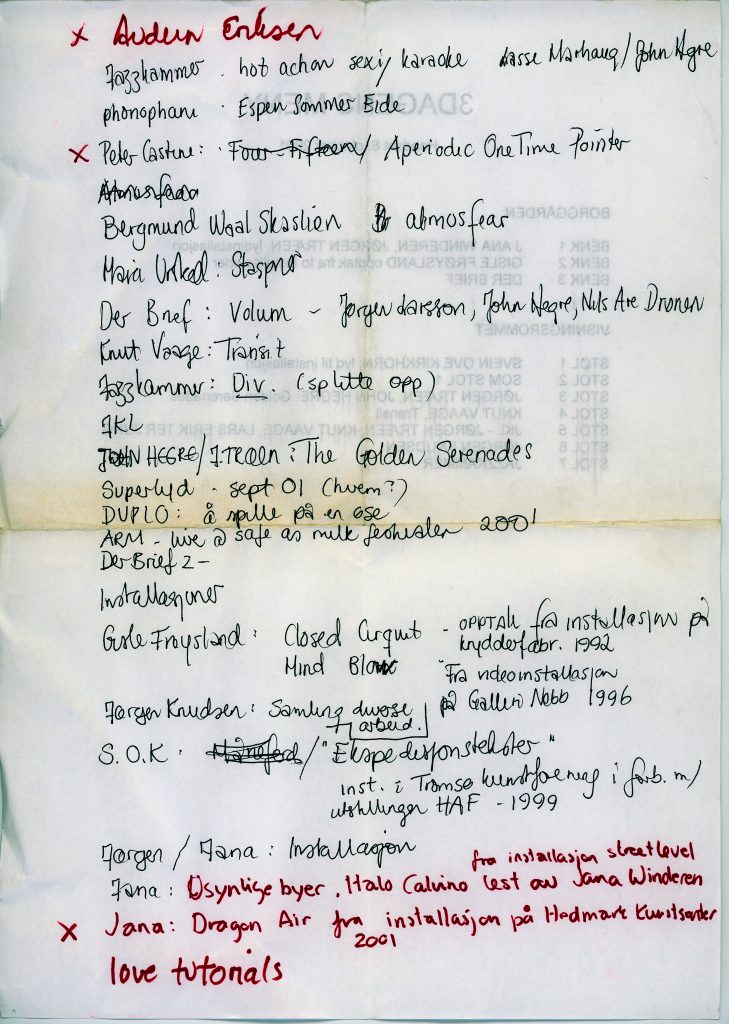
MU: Yes. It was, for example, Norbert Schlieve, who was invited to make an installation. He arrived in a truck, where he had a simple record production studio. He claimed that in 10 years (i.e. in the year 2000), CDs would be gone — but his LPs in copper would live.
JT: He talked about how they could last for 1,000 years or something. Didn’t he make video on the vinyl records?
MU: I think he turned visual signal into sound, that was part of what he was doing. And then he had two tracks on this record. I think it was like that. He brought all the equipment with him in the back of the car, and had an exhibition and gave a talk.
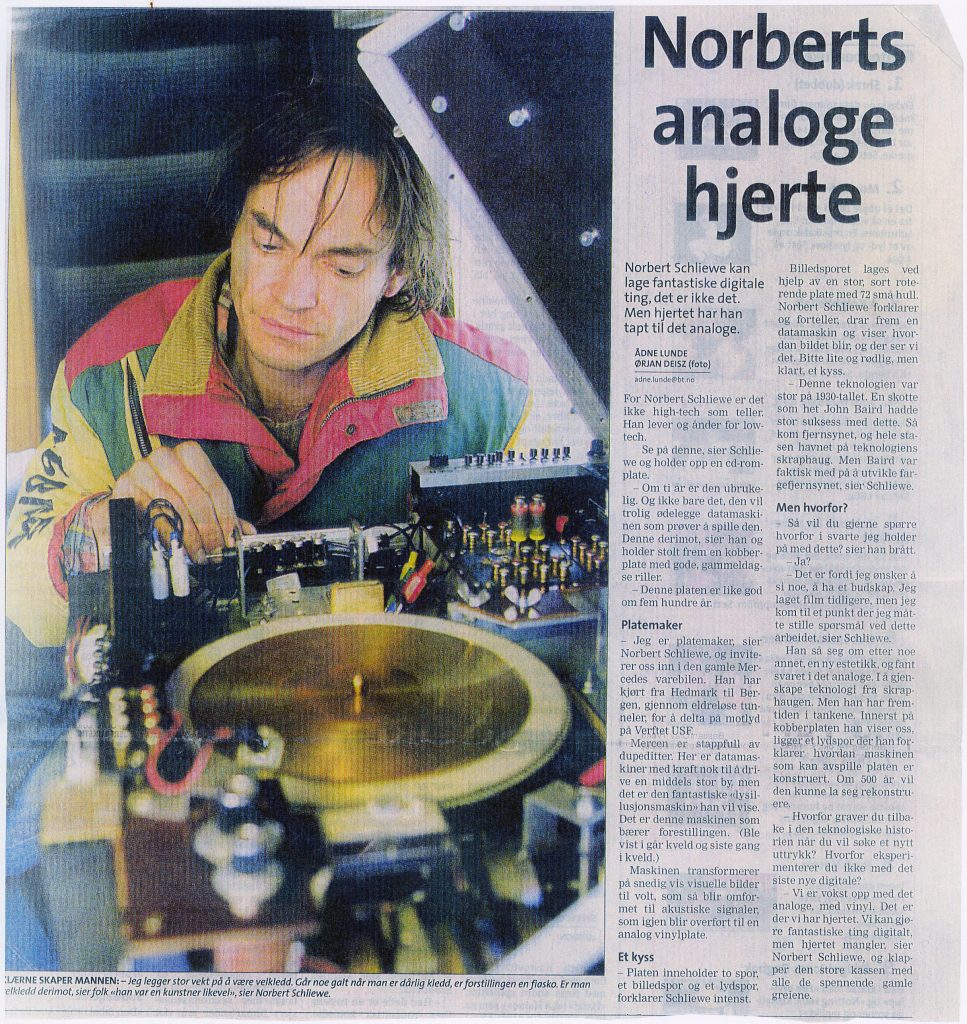
“The Mercedes is full of gadgets. Here are computers with enough power to run a medium-sized city, but it is the wonderful “light illusion machine” he wants to show. (…) The machine cleverly transforms visual images into volts, which are then converted into acoustic signals, which in turn are transferred to an analog vinyl record.”
– Bergens Tidende meeting Nobert Schliewe
The Aftermath
SL: What are you left with after the festival?
MU: It was a bit of a weird festival, with an incredible amount of nice things going on. We had a slogan: “Sound as noise, noise as sound, sound as art.” And that was really what it was. There was no difference between the two. All of this was interesting, and it was interesting that it was going to happen. And it was an interesting context to be in for us.
JW: You and I did motlyd five years later, Maia, remember that? At UKS [Young Artists’ Society].
MU: Yes, we did. It was a series of lectures, a whole day. “Sound Art in the White Cube,” it was called.
JW: It was important that it was in the gallery space, because one had experienced so many stupid situations with curators who just turned the sound up and up, little by little. They had a very poor understanding of sound in a gallery space, really. Of course, things have changed, now, if not very much. Yes, some things have changed a lot.
MU: There’s a long way to go.
JW: Yeah, there’s a long way to go. But there is a greater understanding of sound now in the visual arts context than when we were dealing with motlyd.
SL: At least one does get away with being ignorant today. You could do that then. Then one could simply ignore it, but not now. So in that sense, it has changed.

Just do it
SL: Do you think a similar project could have been done today?
MU: Yes. By young people. Because, it’s a bit about getting up fresh on a stage and doing what you want to do. Young people come in and take the stage by storm, constantly. We may not have been that young then, but it was fun anyway. And it felt young. It was new.
SL: What I mean is not just motlyd as a concept, but what you put into it. That you just did it, as you say yourself, “we just wanted to find out things.”
MU: Yes, we had done it with the needs we have today.
JW: You are somewhere else in life and stuff, but I would have no problem doing that kind of project again.
JT: But you might think about that kind of project, not necessarily that it was us, right?
SL: Both, maybe. Because only you can answer if you could have done it, others are a little difficult to draw into this context. But you say, Jørgen, that to a certain extent it was un-clean, it was composed of very many different things present in the same project, and it was precisely an aspect of playfulness, of curiosity, that was appealing. While today, many of the projects you see or experience are a little cleaner.
JW: I always start things like that, because I want to find something out. That’s really what the whole thing is about, for my part at least. To continue to ask questions, and go where you think there is something to find out, which is interesting.
SL: Are you saying, Jana, that motlyd is something that is repeated absolutely all the time, because that’s the way you work?
JW: That’s the way to do things, yes. Now I have just repaired the roof of the barn here, so in the middle of the Covid-thing I suddenly had a large room. Then I start thinking, ok, what can I use this for? Well, I cannot travel anywhere, cannot invite anyone. But what is it that is around here? How is the sound right around here? I live with my studio in the middle of a field, with the sound of a bus going around. Suddenly it became completely quiet, under the Covid-stuff, during the lockdown. How does it affect people? Who can I invite here to do things? And that’s how I kept going, then. I keep on like that all the time.
SL: So motlyd was really a practice that you continue with. And this experimental approach is the foundation of how you work?
MU: Yes.
JW: That’s how you work. Or, it’s inside the sound itself, perhaps, where you’re still working, and which I’m sure you Jørgen has been doing all along. You are inside the sound and find out things all the time.
JT: Yes, it’s eternal research.
JW: That’s it. And it takes place inside the space, inside the sound, and in relation to people and beyond in the space — it’s the same exploration that you do all the time. Read things, find out things and listen to things. And sharpen, right, that’s what you do. We use exactly the same method all the time.
MU: At the same time, we do it in different ways, because that’s the way we have to learn, that’s the way we have to expand. I think we all are researching what we are doing, continuously. It’s never going to stop. motlyd was part of it. It was fun to make a 10-day thing, and that’s what it was. And now we do it in a different way, maybe, but we really do the same thing: we are learning and figuring things out, I think.
SL: And sometimes small pockets of time appear where you have a more intensive research week with colleagues, so to speak. I think it is an important aspect of motlyd that it so much had the element of play, if I can use that expression. Precisely because one has not decided what the answer will be. Because it’s not just about you. One thing was that you were concerned with the topic, but the fact that you invited others inside, is the important difference. You dragged us into this room and said, “Listen, please check out this, and this, and see what happens if we do that.” Fantastic, really, very inclusive. Not that I remember the sound I was sitting and listening to in the deckchair. That’s not the most important thing. But I remember that it happened and that it opened up another way to sharpen my ears.
MU: We made a connection, or a place, where we could do things ourselves, because no one else did. I think that was very important. For me, it was important that there were many of us, there was a lot that happened at the same time, and that we were part of it. We were not producers in that sense, we were co-players. We made our own stuff in there, and that was very important. Because otherwise it would not have happened.
JW: No.
MU: And then we would not have had a place to show these things either.
JW: That’s what’s important. You don’t have to sit and wait to be invited to things, you can just do it.
MU: Yes. That’s very important.
JW: And it’s actually very possible. And if you don’t have a room, then you can use the street or a park or wherever, if you want to convey something.
MU: Just do it.
JW: Just do it.
